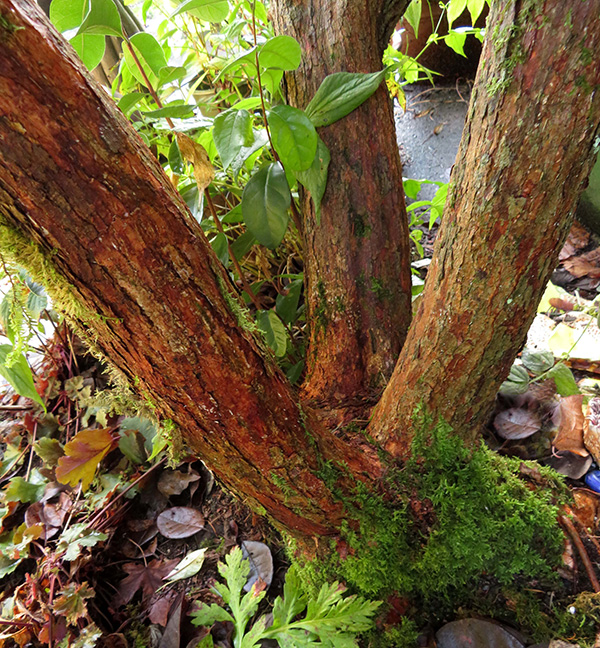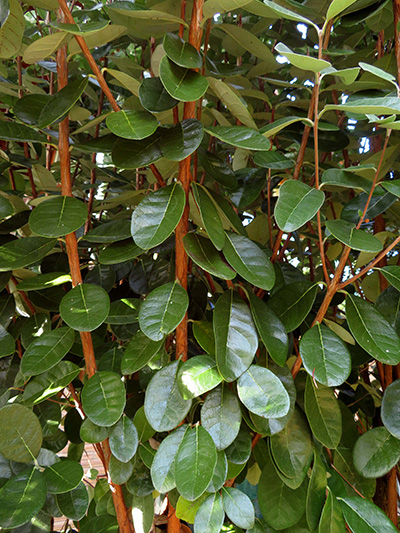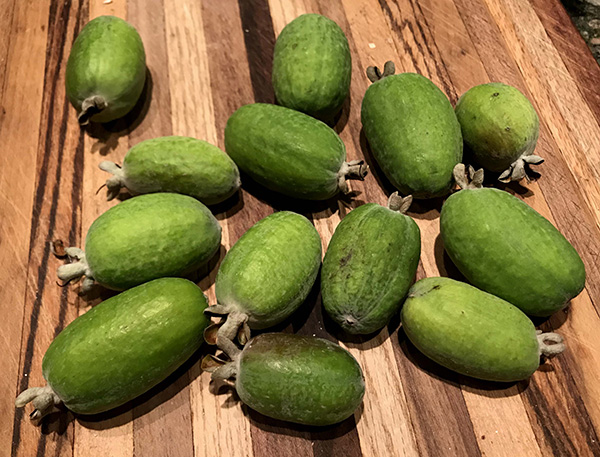
A Marvelous Myrtle: Acca sellowiana (Pineapple Guava)
January, 2021

As this barely born new year dishes out dollops of hope and horror in ever more frenzied fashion, I find myself prying my eyes from the doom-screen of the laptop to seek visual shelter in the upright, outstretched arms of the nearest evergreen, a 25-year-old Acca sellowiana that stands vigil just outside the second-story window near the dining-room table that does double duty as my workspace. Reliable, pliable, versatile and generous, this sturdy shrub has given me a quarter century of service. It asks for so little; how is it that I’ve undervalued it for so long? When it dawned on me how frequently I’d been staring at it of late, I began to evaluate, as if for the first time, its individual components: handsome trunk, attractive foliage, jewel-box flowers, and—in theory—tasty fruit. Let’s contemplate the understated charms of this productive garden denizen, which also answers to the botanical name of—and is usually marketed as—Feijoa sellowiana 1.

Before delving into a detailed physical description, we will consider the plant’s provenance. Indigenous to the subtropical uplands of southern Brazil and adjacent portions of Paraguay, Uruguay and Argentina, Acca is another South American member of the sprawling myrtle family (Myrtaceae) that, like its relatives Luma apiculata and Ugni molinae, produces edible fruit and is winter hardy in most parts of our region west of the Cascades. In comparison with this kindred pair of myrtles, however, Acca is a better behaved and more robust grower for us, unlike the scraggly and unreliable Ugni; it is also tidier and does not self-sow with abandon, in stark contrast to the otherwise appealing Luma.
“Pineapple guava,” its common name in the United States, is one of the felicitous but rare instances in which a plant’s vernacular moniker isn’t too far off the mark, as both guavas and pineapples are—like Acca sellowiana—also natives of Brazil, and true guavas (of the genus Psidium) are in the myrtle family as well. Other common names in English-speaking countries include guavasteen, fig guava, and Brazilian guava. In New Zealand, where it is oddly ubiquitous—its seasonal fruit as commonly eaten as kiwis—it is simply known as feijoa. Pronounce this “fay-JOE-ah,” with the “j” taking the French pronunciation, like the “s” in “pleasure” or “measure”.


Back to basics: For us, the greatest utility of Acca (or if you will, feijoa) is as a dependable evergreen shrub or small tree, good-looking in all seasons, that can serve multiple uses. Grow it as an ornamental specimen, as back-of-border screen or as hedging; it also makes a fine habitat for nesting birds. Acca responds exceptionally well to pruning in early spring. You can pollard it for height control, espalier it to encourage flowering and fruiting, limb it up to reveal the alluring trunk and brawny, vase-shaped branches that sport slightly exfoliating bark. As the years pass the lower branches and trunk develop a rich texture of ochre and umber shades, adorned in moist months with plush spikemoss such as Selaginella oregana.
A couple of years after planting, you should be rewarded from late May through July with incredible-edible flowers. The succulent petals (actually, sepals in this case) are like luscious pillows, pink on top, white underneath, and sweet as cotton candy. They surround the floral fireworks of several dozen ruby-red stamens that end in canary-colored anthers. Don’t try chomping on the stamens; they’re tough as toothpicks. Simply pluck off the delectable sepals and plop them straight into your mouth. If you’re more patient than I, save them to add to a salad, a fizzy lemonade or a smart cocktail.
In our cool Salish Sea zone, fruit production is challenging, as it requires a protracted, warm spring to autumn season. That said, I had my first harvest (a couple of dozen fruit) in November of 2019. Cute as can be, shaped like itty-bitty watermelons, their custardy flesh tastes of tangy pineapple mixed with pear. With climate change, fruiting in these parts is likely to happen with greater frequency. Proper siting also helps: My friend Mané harvests a bonanza of pineapple guavas each fall from his espaliered, west-facing specimen in North Seattle.
You can increase the likelihood of fruiting by planting one of around a dozen named cultivars such as ‘Apollo’ or ‘Coolidge’ that have been especially developed for heavier fruiting in cooler climates. An online search will reveal regional sources for these. By far the most complete selection, offering at least 10 cultivars as well as lots of useful growing tips, can be found on the website of Portland’s One Green World nursery.
Next time we will continue our exploration of garden-worthy natives of our Latin American neighbors. Enjoy the lengthening daylight hours!
Horticulturally yours,
Daniel
1 Nomenclature notes: This plant was first described, in 1859, as Feijoa sellowiana, but reclassified as Acca sellowiana in 1941 when Feijoa was folded into the genus Acca. Both are listed as synonyms today by the International Plant Names Index. The former genus honors João da Silva Feijó, a Portuguese botanist born in Brazil. The latter, Acca, derives from a Peruvian indigenous language term for guava. The specific epithet honors German naturalist Friedrich Sellow, a major collector of Brazilian flora.
